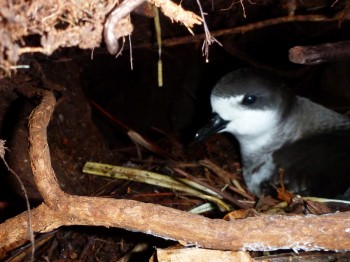Anne Wiley (Department of Zoology, Michigan State University, East Lansing, USA and colleagues writing in the Proceedings of the National Academy of Sciences of the United States of America, have looked at isotopes in the bones of the Vulnerable Hawaiian Petrel Pterodroma sandwichensis, a species listed by the Bonn Convention on Migratory Species (CMS).
The paper’s abstract follows
“Human exploitation of marine ecosystems is more recent in oceanic than near shore regions, yet our understanding of human impacts on oceanic food webs is comparatively poor. Few records of species that live beyond the continental shelves date back more than 60 y, and the sheer size of oceanic regions makes their food webs difficult to study, even in modern times. Here, we use stable carbon and nitrogen isotopes to study the foraging history of a generalist, oceanic predator, the Hawaiianpetrel (Pterodroma sandwichensis), which ranges broadly in the Pacific from the equator to near the Aleutian Islands. Our isotope records from modern and ancient, radiocarbon-dated bones provide evidence of over 3,000 y of dietary stasis followed by a decline of ca. 1.8‰ in δ15N over the past 100 y. Fishery-induced trophic decline is the most likely explanation for this sudden shift, which occurs in genetically distinct populations with disparate foraging locations. Our isotope records also show that coincident with the apparent decline in trophic level, foraging segregation among petrelpopulations decreased markedly. Because variation in the diet of generalist predators can reflect changing availability of their prey, a foraging shift in wide-ranging Hawaiianpetrel populations suggests a relatively rapid change in the composition of oceanic food webs in the Northeast Pacific. Understanding and mitigating widespread shifts in prey availability may be a critical step in the conservation of endangered marine predators such as the Hawaiian petrel.”

Hawaiian Petrel. Photograph by Andre Raine
To read more on this study click here.
Reference:
Wiley, A.E., Ostron, P.E., Welch, A.J., Fleischer, R.C., Gandhi, H., Southon, J.R., Stafford, T.W., Penniman, J.F., Hu, D., Duvall. F.P. & James, H.F. 2013. Millennial-scale isotope records from a wide-ranging predator show evidence of recent human impact to oceanic food webs. Proceedings of the National Academy of Sciences of the United States of America 110: 8972-8977.
John Cooper, ACAP Information Officer, 13 June 2013

 English
English  Français
Français  Español
Español